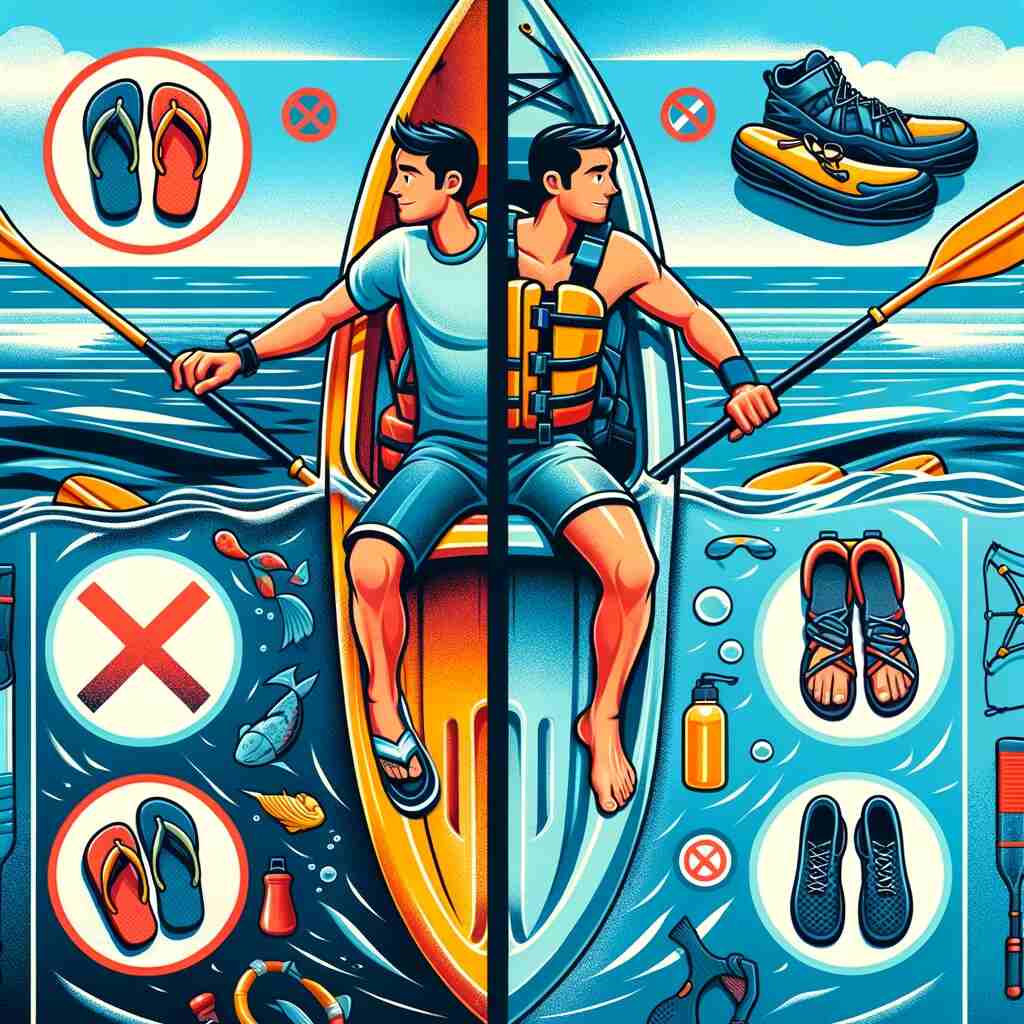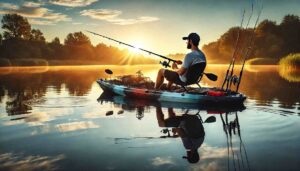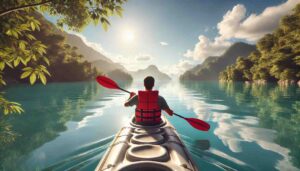Kayaking is a fantastic outdoor activity that allows you to connect with nature while exploring the beauty of rivers, lakes, and oceans. Whether you’re a seasoned kayaker or a beginner, choosing the right gear is crucial to ensure your safety and comfort on the water. One common question that often arises is, “Can you wear flip-flops kayaking?”
Kayakers are strongly advised to opt for closed-toe water shoes that are suitable for getting wet. Flip-flops or sandals are not recommended for safety reasons.
In this article, we’ll delve into this question and provide you with the information you need to make an informed decision about your kayaking footwear.
Understanding the Importance of Proper Footwear
Before we dive into whether or not you can wear flip-flops while kayaking, it’s essential to understand why proper footwear is so important when engaging in this water sport. Your choice of footwear can significantly impact your kayaking experience, safety, and overall enjoyment.
- Foot Protection: Kayaking often involves navigating through rocky or uneven terrain, both in the water and on land. Adequate foot protection is essential to prevent injuries from sharp rocks, debris, or even aquatic creatures that may accidentally come into contact with your feet.
- Grip and Stability: Proper footwear provides the necessary grip and stability to help you maintain control of your kayak. Slippery surfaces, such as wet rocks or a wet kayak deck, can pose a significant challenge when wearing inadequate footwear.
- Comfort: Comfort is key when kayaking for extended periods. Uncomfortable or ill-fitting shoes can lead to blisters, soreness, or cramps, which can quickly turn your kayaking adventure into a painful experience.
- Safety: In case of an emergency, like capsizing or needing to exit your kayak quickly, your choice of footwear can impact your ability to move swiftly and safely. Bulky or inappropriate footwear can hinder your agility in such situations.
Now that we understand why proper footwear is essential for kayaking, let’s explore the suitability of flip-flops for this activity.
The Case for Not Wearing Flip-Flops While Kayaking
Flip-flops, although comfortable and convenient for many casual activities, have several drawbacks when it comes to kayaking. Here are some reasons why wearing flip-flops on a kayaking trip may not be the best idea:
- Lack of Support: Flip-flops offer minimal support to your feet, which is crucial when you need to paddle effectively and maintain balance. The thin rubber sole provides little cushioning and no arch support, which can lead to discomfort and fatigue during long kayaking sessions.
- Risk of Slippage: Flip-flops are notorious for their lack of traction. When your feet are wet, as they inevitably will be while kayaking, the chances of slipping and losing your balance increase significantly. This can lead to capsizing or injuries, especially in fast-moving or challenging water conditions.
- Inadequate Protection: Flip-flops offer minimal protection for your feet. They leave most of your foot exposed, making it vulnerable to abrasions, cuts, and impact injuries, particularly in rocky or rough water environments.
- Difficulty in Emergencies: In case of an emergency, such as needing to exit your kayak quickly or swim to safety, flip-flops can impede your ability to move swiftly. Their flimsy straps and loose fit can easily get caught on kayak equipment, potentially putting you in a dangerous situation.
- Water Retention: Flip-flops tend to absorb water and stay wet for an extended period. This can make your feet cold and uncomfortable, leading to a less enjoyable kayaking experience, especially in cooler weather.
Considering these factors, it’s clear that flip-flops may not be the best choice for kayaking, especially if you are planning a more challenging or extended trip. So, what alternatives should you consider?
Suitable Footwear Options for Kayaking
Now that we’ve established the limitations of flip-flops for kayaking, let’s explore some suitable footwear options that will better serve you on the water:
- Water Shoes: Water shoes are designed specifically for water sports like kayaking. They provide excellent grip on wet surfaces, offer adequate foot protection, and are designed to drain and dry quickly. Many water shoes also have a snug fit and adjustable straps to prevent them from slipping off in turbulent waters.
- Neoprene Boots: Neoprene boots are another excellent choice for kayaking, especially in colder conditions. They provide insulation to keep your feet warm and offer good protection against sharp rocks and debris. Neoprene boots typically have rubber soles with sturdy traction.
- Wet Socks: If you prefer a minimalist approach, wet socks can be an option. These socks are made of quick-drying materials and are designed to be worn in water. While they won’t provide as much protection as water shoes or neoprene boots, they can be a good compromise between comfort and minimalism.
- Closed-Toe Sandals: If you’re insistent on the idea of sandals, consider closed-toe sandals designed for outdoor activities. These sandals offer more foot protection than traditional flip-flops while still providing breathability and water drainage.
- Kayaking Booties: Some kayakers opt for specialized kayaking booties made explicitly for the sport. These booties are designed to provide the best combination of protection, comfort, and agility for paddlers.
- Barefoot Kayaking: For some kayakers, going barefoot is a viable option, especially in warm weather and calm waters. However, this choice should be reserved for experienced kayakers who are comfortable with the potential risks and challenges of paddling without footwear.
Ultimately, the best choice of footwear for kayaking depends on your specific needs, preferences, and the conditions of your kayaking trip.
Additional Tips for a Safe and Enjoyable Kayaking Experience
Now that we’ve covered the topic of footwear, here are some additional tips to ensure a safe and enjoyable kayaking experience:
- Check the Weather: Always check the weather forecast before heading out for a kayaking adventure. Be prepared for changing weather conditions, and dress appropriately to stay comfortable.
- Wear a Personal Floatation Device (PFD): Regardless of your skill level or the type of kayaking you plan to do, wearing a PFD is essential for safety. It can be a lifesaver in case of unexpected situations.
- Inform Someone of Your Plans: Before you embark on your kayaking trip, let a trusted friend or family member know your plans, including your expected return time. This ensures that someone can raise the alarm if you encounter difficulties.
- Carry Essential Gear: Depending on the nature of your kayaking trip, carry essential gear such as a first-aid kit, a whistle, a knife, and a waterproof communication device like a marine radio or a waterproof smartphone case.
- Stay Hydrated and Sun-Protected: Bring plenty of water to stay hydrated, and wear sunscreen and sunglasses to protect yourself from the sun’s harmful rays. Sunburn and dehydration can quickly spoil your kayaking experience.
- Know Your Limits: Be aware of your own skill level and the capabilities of your kayak. Don’t attempt challenging or risky waters unless you are well-prepared and experienced.
- Leave No Trace: Respect the environment by following Leave No Trace principles. Pack out all trash and avoid disturbing wildlife.
- Take Kayaking Lessons: If you’re new to kayaking or want to improve your skills, consider taking kayaking lessons from a certified instructor. They can teach you essential techniques and safety measures.
Conclusion
In summary, while flip-flops may be suitable for casual beach outings, they are not recommended for kayaking due to their lack of support, poor traction, and inadequate protection. Proper footwear is essential to ensure your safety, comfort, and enjoyment while kayaking. Consider alternatives such as water shoes, neoprene boots, wet socks, closed-toe sandals, or specialized kayaking booties, depending on your needs and preferences.
Always prioritize safety when planning a kayaking trip by checking the weather, wearing a PFD, informing someone of your plans, carrying essential gear, and being aware of your own limits. By making informed choices and following safety guidelines, you can have a fantastic and memorable kayaking experience that allows you to fully appreciate the beauty of nature while staying safe on the water.










